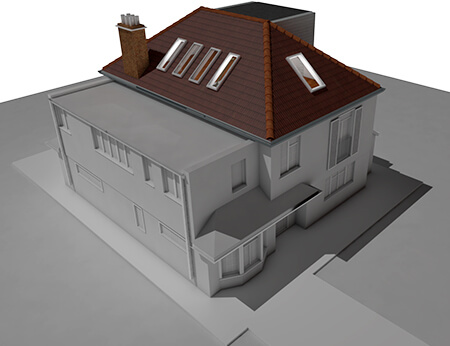
How to Cool Down an Attic Bedroom?
Is your attic bedroom a bit too hot? So how do you cool down an attic bedroom? We all know that hot air rises and your attic bedroom is on the receiving end of all the heat from your lower rooms, especially in summertime. Your attic bedroom quickly feels overheated and uncomfortable, forcing you to seek refuge elsewhere. Here are a few tips to keep your attic room cool this summer.
How to Cool Down a Loft Room
Yes, that spooky space that is often dark and prone to moisture and heat problems can be converted into living space. Before you even think of funding to make your attic a liveable space room, there are a few factors you need to consider. They all revolve around controlling temperature and improving air circulation. Some things you can do to cool down your loft room may include:
Rethink your attic room. Rebuild your loft this summer, so it stays cool no matter how hot it is outside.

1. Install a Solar Attic Fan
These are relatively new and sustainable solutions. Powered by solar energy, they ventilate your attic, helping to reduce the build-up of heat.
Alternatively, when your attic bedroom is heating up and you want to cool it down by running a traditional non-solar fan or several if you can afford it. If you are using multiple fans, placing them at different positions could help to effectively cool your attic bedroom. Place one fan near the vent (if there is one), install another on the roof and the other on the wall. While fans do not necessarily produce cold air, they help circulate air in any space, thus providing a cooling effect.
2. Radiant Barrier Insulation
This is a type of insulation that reflects radiant heat, rather than absorbing it. This can help reduce the temperature in the attic by reflecting the heat away from your living space.
3. Geothermal Cooling
This is a more significant investment, but it can drastically reduce your home's internal temperature. This system uses the earth's constant underground temperature to cool the air in a home.
4. Thermal Mass Cooling

Using materials that absorb heat during the day and release it during cooler night hours. This could include installing stone, concrete, or ceramic materials in the attic.
5. Green Roofs
If your roof is flat or low-sloped, you could consider a green roof. This is where the roof is partially or completely covered with vegetation and a growing medium, which provide shade and remove heat from the air through evapotranspiration.
6. Cool Roofs
Cool roofs are designed to reflect more sunlight and absorb less heat than a standard roof. Cool roofs can be made of a highly reflective type of paint, a sheet covering, or highly reflective tiles or shingles.
7. Smart Vents
These use temperature and pressure sensors to regulate the flow of hot and cold air in the house. When it is hot, they will draw more air into cooler parts of the house, like basements, and less into hotter parts, like attics.
8. Ventilate Your Attic

A supply of natural air is vital to the cooling of your attic bedroom by moving the hot air out of the room and allowing cooler air inside. An attic bedroom that lacks proper ventilation will often experience excessive heat problems. Installing several vents at various positions in your attic can go a long way in cooling it down. You only need to decide how you want your ventilation system to be depending on the size of your attic. You could use one of the different types of vents or you could choose to combine the ridge, gable and soffit vents. So if your loft space bedroom is missing ventilation, it is probably high time you installed vents for a cooler environment.
9. Air Conditioner
Air conditioners are not just for offices and ordinary living rooms. An attic bedroom can sometimes get extremely hot, especially in the warmer months such as April. Fortunately, this is something you can solve by installing a portable window AC for a cool attic bedroom. These portable air conditioning system versions provide you with an attic cooling solution without having to spend an arm and a leg or breaking the bank.
10. Attic Insulation Keeps House Cool

Insulating your attic bedroom limits the amount of heat that gets into your room as the insulating material acts as a barrier between the roof and the room. High-performance insulation board is most preferred to resist the heat that would otherwise cause discomfort. To know the proper kind of insulation you need in your house, you will need to get advice from a loft company that has the expertise in the field. To spare yourself the trouble of having to cool your attic bedroom using expensive methods, you are better off adequately insulating your attic.
- With these attic conversion bedroom ideas will keep your room chill in summer and warm in winter.
- How to properly replace a roof so it does not warm up too much.
- Thinking whether you can put a dehumidifier in a loft? Well that one way to solve...

Hot Attic Solutions
A hot attic can be a huge challenge, especially for anyone looking to convert the loft into usable living space. To beat the heat, some of the most common solutions include installing fans, adding ventilation, installing an attic air conditioner or adding insulation. You may also want to invest in a new roof that is reflective if you intend to transform your loft into an extra room in your home.
In summary, there are several methods that you can use to cool down your attic bedroom as listed above. Depending on your attic bedroom and other factors such as energy efficiency and prices, it is always good to determine the best option that works for you. Hopefully, the above few pointers have shed some light and improving the comfort of your attic bedroom will be less of a hurdle at this point.
Clara Annesley
Clara Annesley is an interior design and construction content writer. She holds a BSc (Hons) in Architectural Design Technology from the University of West London. Clara specialises in residential construction for topics like health & safety, architectural design and writing cost guides for renovation and remodelling projects.